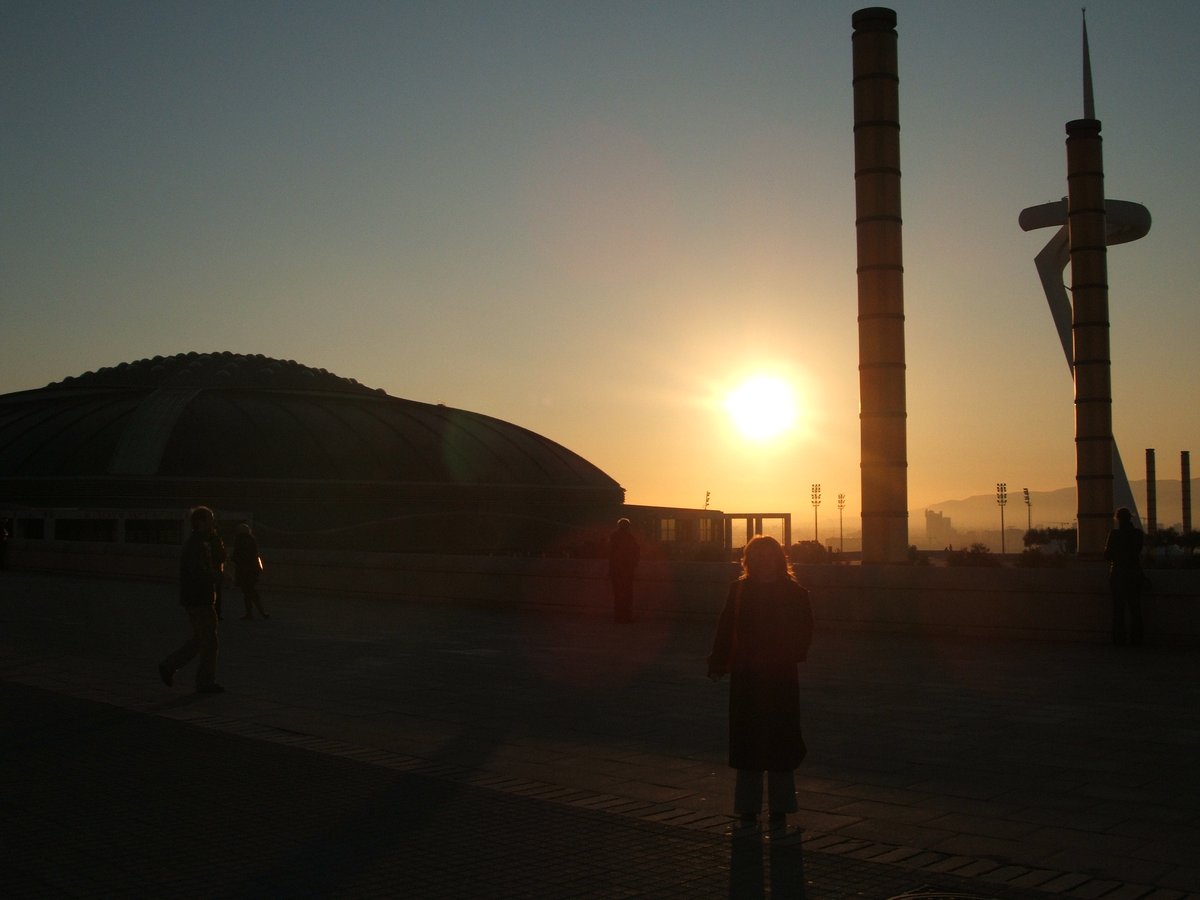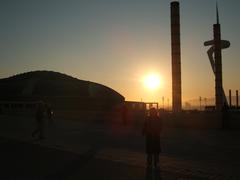
Anella Olímpica Barcelona: Visiting Hours, Tickets, and Guide to Historical Sites
Date: 14/06/2025
Introduction
Nestled atop the picturesque Montjuïc hill, the Anella Olímpica (Olympic Ring) is a testament to Barcelona’s rich Olympic legacy and architectural innovation. Developed as the centerpiece for the 1992 Summer Olympics, it remains a symbol of the city’s transformation and its emergence onto the global stage. Today, the Anella Olímpica seamlessly blends monumental sports venues, public art, and panoramic views, offering an immersive experience for history enthusiasts, architecture lovers, and cultural explorers alike.
This comprehensive guide details the Anella Olímpica’s historical origins, architectural highlights, visitor information, accessibility, and nearby attractions. Whether you’re eager to walk in the footsteps of Olympic athletes, marvel at late 20th-century urban planning, or simply enjoy the vibrant atmosphere, this guide ensures you’ll make the most of your visit.
For current details on schedules, tickets, and guided tours, consult official sources such as the Barcelona City Council, Olympic.org, and the Palau Sant Jordi Official Site. For itinerary planning and real-time updates, digital resources like the Barcelona Turisme portal or the Audiala app are invaluable.
Table of Contents
- Introduction
- Origins and Early Development
- Planning and Construction for the 1992 Olympics
- Symbolism and Urban Transformation
- The 1992 Olympic Games and Global Impact
- Architectural Highlights and Signature Structures
- Visiting the Anella Olímpica: Hours, Tickets, and Accessibility
- Main Facilities & Key Attractions
- Getting There and Navigating the Site
- Nearby Attractions and Travel Tips
- Visitor Services and Practical Tips
- Visuals and Media
- Frequently Asked Questions (FAQs)
- Conclusion
- References
Origins and Early Development
Barcelona’s aspirations to host the Olympic Games date back to the early 20th century. Although the city’s initial bids for the 1924 and 1936 Olympics were unsuccessful due to political upheavals and the Spanish Civil War, Barcelona’s Olympic vision endured. The transformation of Montjuïc began with the 1929 International Exposition, which established the hill as a hub for urban development and culture. When the city secured the 1992 Olympic Games, Montjuïc was chosen as the symbolic and functional heart of the event (Olympic.org, Barcelona.cat).
Planning and Construction for the 1992 Olympics
After winning the Olympic bid in 1986, Barcelona launched an ambitious urban renewal program. The Anella Olímpica was conceived as the Olympic epicenter, integrating new and restored venues within Montjuïc’s landscape. Notable facilities include:
- Estadi Olímpic Lluís Companys: Originally built in 1927 and extensively renovated for the Olympics, the stadium now accommodates up to 60,000 spectators (Estadi Olímpic Lluís Companys).
- Palau Sant Jordi: A cutting-edge indoor arena designed by Arata Isozaki, hosting sports, concerts, and cultural events (Palau Sant Jordi).
- Piscines Bernat Picornell: Refurbished pools that hosted Olympic swimming and diving events.
- Institut Nacional d’Educació Física de Catalunya (INEFC): Designed by Ricardo Bofill, this building served as the Olympic training and administrative hub.
The city’s investments exceeded $9.7 billion (1992 rates), driving widespread modernization (Olympic Legacy Barcelona).
Symbolism and Urban Transformation
The Anella Olímpica stands as a symbol of Barcelona’s urban transformation and modernization. The Olympics spurred infrastructure projects, including new ring roads, expanded airport facilities, and improved public transit (Barcelona City Council). The complex’s design emphasizes openness, landscape integration, and connectivity, with the Plaça d’Europa plaza linking venues and offering sweeping city and sea views. Santiago Calatrava’s Torre de Comunicacions de Montjuïc is a standout example of innovative public art and engineering (Calatrava Tower).
The 1992 Olympic Games and Global Impact
From July 25 to August 9, 1992, Barcelona hosted its first Olympic Games, welcoming over 9,300 athletes from 169 countries. The Anella Olímpica was the stage for the opening and closing ceremonies and numerous competitions, captivating an audience of 3.5 billion worldwide. The Games catalyzed Barcelona’s tourism and solidified its reputation as a cosmopolitan, forward-looking city (Olympic.org).
Architectural Highlights and Signature Structures
Estadi Olímpic Lluís Companys
Initially built in 1929, this stadium features a blend of neoclassical and modernist styles. Its 1992 renovation preserved the historic façade while modernizing the structure. Today, it hosts football matches, concerts, and public events, offering panoramic views of the city (Lonely Planet).
Palau Sant Jordi
Designed by Arata Isozaki, Palau Sant Jordi’s innovative domed roof creates a flexible, column-free interior. With capacity for up to 24,000 attendees, it remains a top venue for sports and entertainment (Palau Sant Jordi).
Torre de Comunicacions de Montjuïc
Santiago Calatrava’s 136-meter telecommunications tower, clad in white mosaic, represents an athlete holding the Olympic torch. It functions as a sundial, merging art, symbolism, and technology (PG World).
Piscines Bernat Picornell
Famed for their Olympic legacy and terraced seating with city views, these pools serve locals year-round and host recreational swimming and competitions (Barcelona.cat).
Explanada Olímpica
This open esplanade links the major venues, featuring public art, fountains, and landscaped gardens. It’s an ideal spot for strolls, photography, and enjoying panoramic scenery (meet.barcelona).
Visiting the Anella Olímpica: Hours, Tickets, and Accessibility
Visiting Hours
- Outdoor areas: Generally open daily, 8:00–22:00 (summer) and 8:00–20:00 (winter).
- Estadi Olímpic Lluís Companys: April–October, 10:00–19:00; November–March, 10:00–18:00. Closed for events on select dates—always check ahead (palausantjordi.barcelona).
- Palau Sant Jordi: Open during scheduled events; not open for casual visits outside event times.
Tickets and Entry
- General access: Free for outdoor spaces and esplanade.
- Venues & Museums: The Olympic and Sports Museum Joan Antoni Samaranch requires a ticket (€6.30; free with Barcelona Card), open Tue–Sat 10:00–18:00, Sun 10:00–14:30 (barcelona-tourist-guide.com).
- Pools: Entry fees apply; check Piscines Bernat Picornell for rates and hours.
- Events: Tickets are required for concerts and major sporting events at the stadium or Palau Sant Jordi.
Accessibility
- The Anella Olímpica is fully accessible, featuring ramps, elevators, and wide, gently sloping paths.
- Public transport options include metro (Espanya station, L1/L3), Montjuïc funicular, and Bus 150 for convenient access.
Guided Tours and Special Events
- Guided tours are available for deeper insight into the site’s history and architecture.
- Special events, concerts, and festivals frequently take place—consult official event calendars for closures or restricted access.
Main Facilities & Key Attractions
- Estadi Olímpic Lluís Companys: Historic stadium, panoramic views, frequent events.
- Palau Sant Jordi: Modern arena for sports and concerts.
- Explanada Olímpica: Open-air promenade, ideal for walking and photography.
- Torre de Comunicacions (Calatrava Tower): Striking landmark, excellent photo opportunities.
- Piscines Bernat Picornell: Olympic swimming pools open to the public.
- Olympic and Sports Museum Joan Antoni Samaranch: Interactive exhibits and memorabilia from Barcelona’s Olympic history.
Getting There and Navigating the Site
Public Transport
- Metro: Take L1 or L3 to Plaça Espanya, then walk (25 minutes uphill) or transfer to Bus 150 for direct access.
- Montjuïc Funicular: Connects from Paral·lel station; combine with the Montjuïc Cable Car for a scenic approach (bcn.travel).
- Bus Turístic: The red route stops near the Olympic Ring.
By Car
- Parking is available near major venues, but limited during events. Public transport is recommended for convenience.
Layout and Accessibility
- The complex centers on Plaça Nemesi Ponseti, adjacent to the stadium.
- Wide, accessible promenades connect all main attractions, though some paths are steep due to the hillside location.
Nearby Attractions and Travel Tips
- Montjuïc Castle: Historic hilltop fortress with city views.
- Magic Fountain of Montjuïc: Renowned for its evening light and music displays.
- Museu Nacional d’Art de Catalunya (MNAC): Premier art museum in a palatial setting.
- Poble Espanyol: Open-air museum of Spanish architecture and culture.
Travel Tips:
- Wear comfortable shoes, carry water, and bring sun protection.
- For food, there are limited kiosks and cafés within the complex; nearby neighborhoods such as Poble-sec and Sants offer diverse dining options.
- Combine your visit with other Montjuïc attractions for a full-day itinerary.
Visitor Services and Practical Tips
- Restrooms: Available at the museum, stadium, and Palau Sant Jordi during opening hours.
- Accessibility: Ramps and elevators throughout; accessible public transport.
- Shaded Areas: Limited on the esplanade—plan for hot weather.
- Souvenirs: Available at the museum shop.
- Security: The area is safe, but always watch your belongings, especially during large events.
Visuals and Media
- High-resolution images and panoramic views are available throughout the site.
- Official tourism websites offer interactive maps and virtual tours.
- Use optimized alt tags such as “Anella Olímpica visiting hours panoramic view” and “Palau Sant Jordi ticket entrance” to enhance search visibility.
Frequently Asked Questions (FAQs)
Q: What are the Anella Olímpica visiting hours?
A: Outdoor areas are open daily, typically 8:00–22:00 in summer, 8:00–20:00 in winter. Venue hours vary—check official sites.
Q: Do I need a ticket to visit?
A: Outdoor areas are free. Tickets are needed for the Olympic and Sports Museum, swimming pools, and events at major venues.
Q: Is Anella Olímpica accessible for people with disabilities?
A: Yes, the complex is fully accessible with ramps, elevators, and accessible transport links.
Q: How do I get there by public transport?
A: Metro (L1/L3 to Plaça Espanya), Bus 150, Montjuïc Funicular, and hop-on-hop-off buses all serve the area.
Q: Are guided tours available?
A: Yes, guided tours are available—check schedules on official websites.
Conclusion
The Anella Olímpica is a vibrant testament to Barcelona’s Olympic legacy, urban renewal, and architectural ambition. With its blend of historical venues, striking modern design, and inviting public spaces, it offers a memorable experience for all visitors. Plan your trip by checking up-to-date visiting hours, event schedules, and ticket options, and consider exploring nearby Montjuïc attractions for a full day of cultural discovery.
For the latest updates, guided tours, and personalized itineraries, download the Audiala app and follow us on social media. Make the most of your Barcelona visit by exploring everything the Anella Olímpica and Montjuïc have to offer!
References
- Anella Olímpica Barcelona: Visiting Hours, Tickets, History & Attractions, 2025, Barcelona.cat
- Visiting Anella Olímpica: Hours, Tickets, and Exploring Barcelona’s Olympic Ring, 2025, Barcelona.cat
- Anella Olímpica Barcelona: Visiting Hours, Tickets, and Key Attractions, 2025, Palau Sant Jordi
- Anella Olímpica Visiting Hours, Tickets, and Insider Tips for Exploring Barcelona’s Historical Sites, 2025, Barcelona Tourist Guide
- Olympic Legacy Barcelona, 2025, Olympic.org
- Barcelona City Council, 2025, Ajuntament de Barcelona
- Meet Barcelona: Points of Interest - L’Anella Olímpica
- PG World: Anella Olímpica Montjuïc Tour
- Piscines Bernat Picornell
- Bcn.travel: Anella Olímpica






























































